I only wish there was something about train wrecks in here. But that might require another axis.
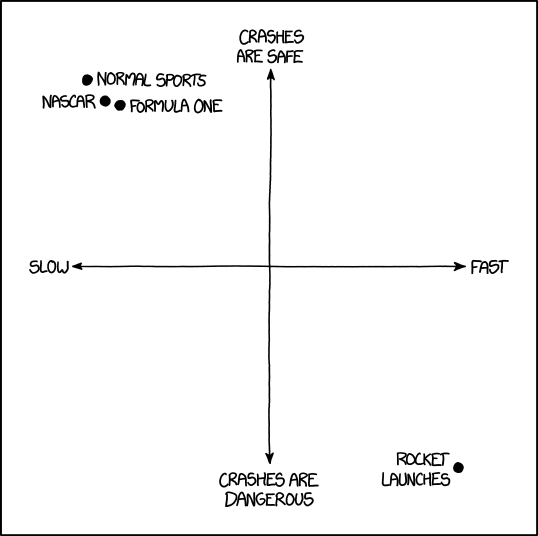
Credit for the piece goes to Randall Munroe.
Who said British politics are boring? With David Cameron out and Theresa May in as Prime Minister, it is time to reshuffle the cabinet. And the Guardian is reusing the style they had for the Jeremy Corbyn shadow cabinet mass resignation. Except in this case, the colours reflect the Tory’s position on Brexit.
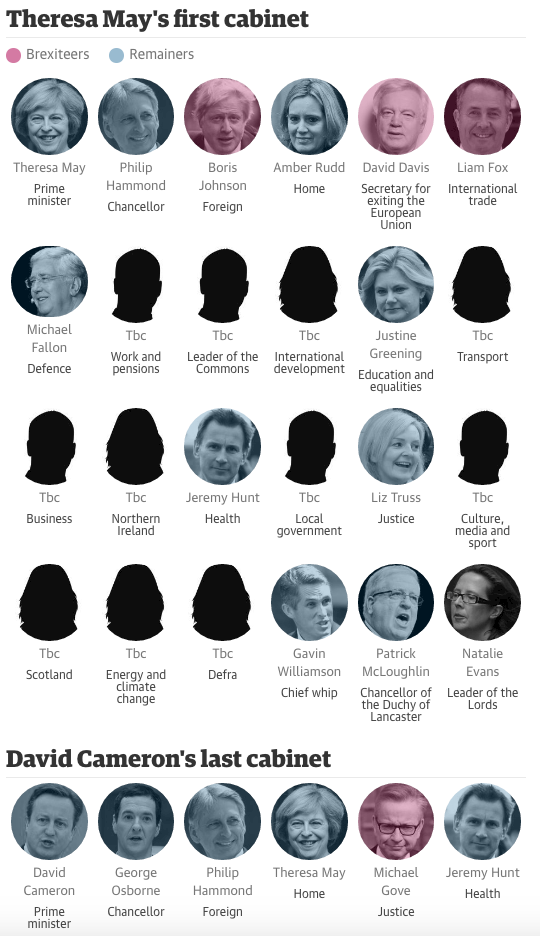
Credit for the piece goes to the Guardian graphics department.
In US presidential politics, the common sense truth is that candidates run to the wings of the parties to get primary voters. They say ridiculous, inane things, but with the hope to walk them back later. Why? Because while they commonly run to the outsides edges during primary season, candidates recognise that in the election itself, victory comes from the moderates. And yesterday, the Economist published a really nice piece on this point.
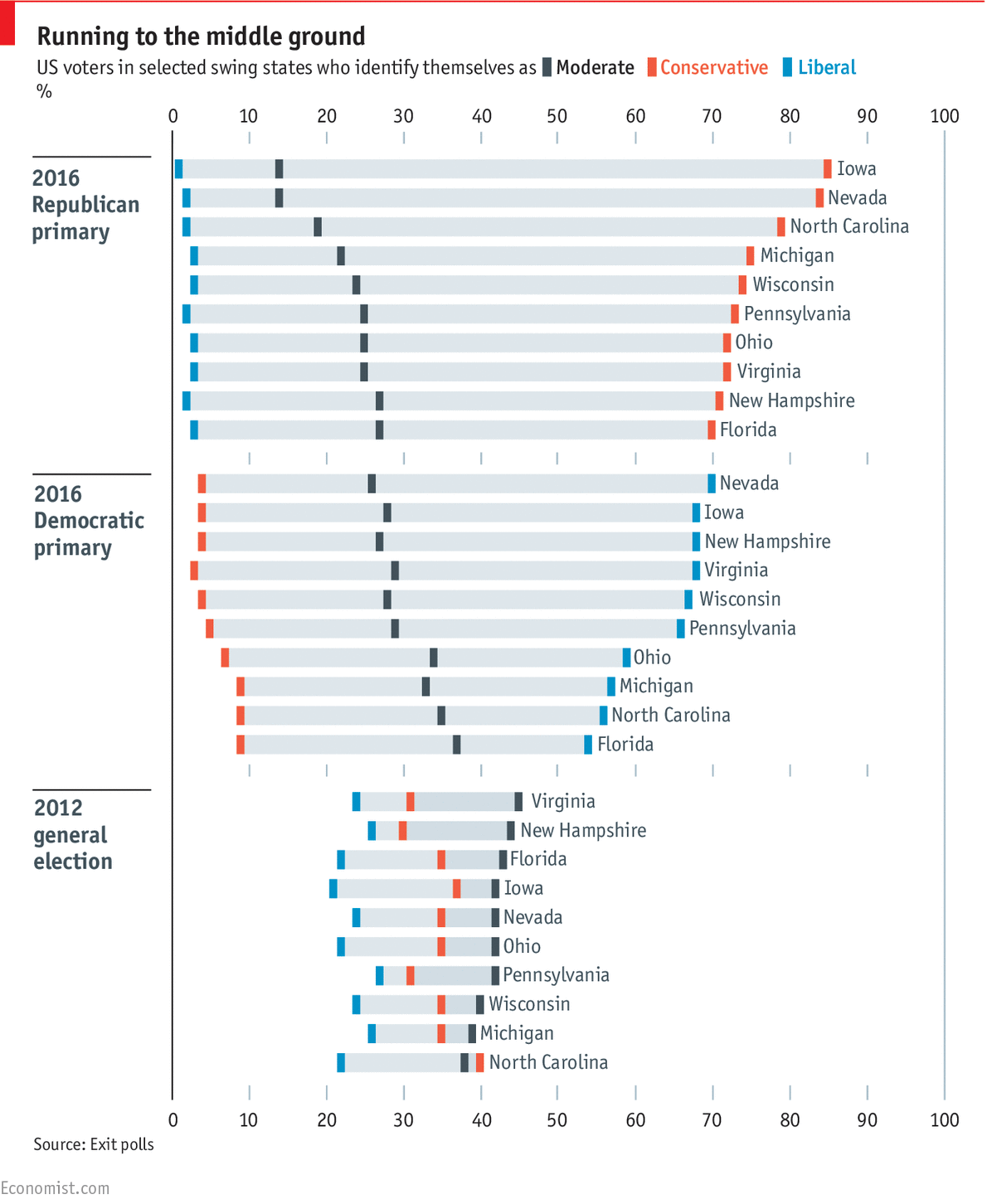
For a sample of battleground states, the Economist examined who voted in the recent primaries versus who voted in the last general election. Given the aforementioned common thinking, not surprisingly self-identified Democrats voted in droves for the Democratic primaries. And self-identified Republicans voted in the Republican primaries. When one looks at the historical 2012 data, however, with the exception (barely) of North Carolina, moderates out voted Democrats and Republicans in all the battleground states.
Not every chart needs to show revolutionary data. Sometimes data can simply validate widely-held truths that people know without knowing the data and facts behind them. And that is what this piece from the Economist does.
Credit for the piece goes to the Economist Data Team.
Yesterday, I left the office late and encountered a protest in front of my building organised by the Black Lives Matter movement. The protest focused on recent shooting deaths of black men by police officers in Minneapolis and Baton Rouge, but the protests clearly tapped into deeper issues regarding race, inequality, and armed police among others. But in a far more tangible sense, I am left curious what has happened to the police officers involved in these cases? I figured today would be a good day to share the New York Times work on the follow-ups. The piece looks for accountability or the lack thereof in police shootings of civilians. Additional tables look at settlements and Justice Department investigations.
What has happened afterwards
The piece does a nice job of using tables to organise and showcase the results of the investigations. Something about the colour choices feels off; I am far more quickly drawn to the negative results as opposed to the positives. Should that be the idea? Regardless, the work shows that tables, while not the sexiest visualisation form available, have an important role to play in designing displays of information.
Credit for the piece goes to Haeyoun Park and Jasmine C. Lee.
Another Monday, another week, another post. But this week we will try to get by without any more Brexit coverage. So what better way to cure a hangover than with more booze? So let’s start with some fancy wine.
I meant to post this piece a little while back, but yeah that unmentionable thing occurred. Now we have the time to digest as we sip and not slam our beverage of choice—the Sun’s over the yardarm somewhere I figure. FiveThirtyEight took a look at expensive wines. It compares the pricing at various vintages for France, California, and other wine-producing regions. On the balance, a very smart piece with some great graphics.
But since I had to pick just one, since this isn’t a full-on critique, I opted for this set of small multiples. It compares the price vs. vintage for a number of California red wines. (One of which I had this weekend.)
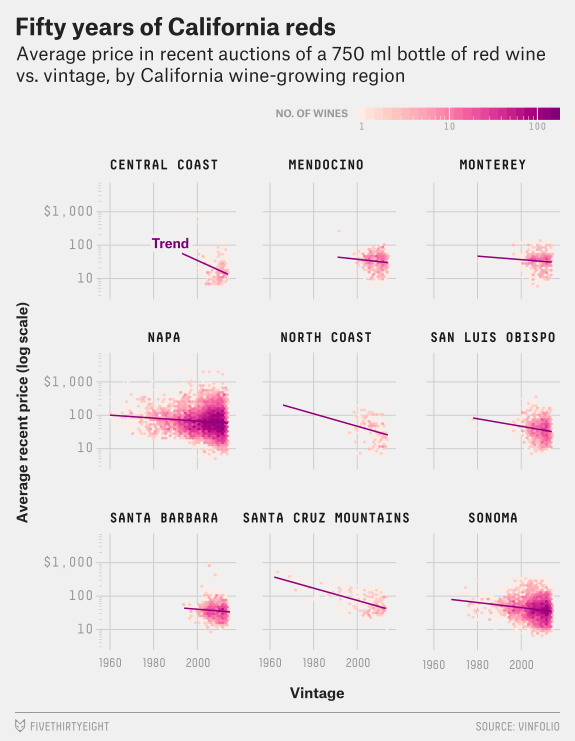
Credit for the piece goes to Oliver Roeder.
Last one of these critiques—I promise. Earlier this week I looked at the New York Times’ coverage and the BBC’s coverage. Well, today I want to examine the Guardian’s coverage of the Brexit vote results. This piece differs the most from the preceding work and it starts right from the top, literally.

I am not the biggest fan of the illustrations of David Cameron and Boris Johnson, but in a sense, neither is a throw-in. For the last few months, the Guardian has been using these and similar illustrations of US presidential candidates to tie results into different political camps. Thus in that sense, they do fit the Guardian’s current brand. Interestingly, neither remains (pun intended) in the picture for the future of the Tories.
Data-wise, however, the decision to use the bar chart at the outset of the piece reflects an understanding of the importance of the top-line number. Districts count, but only at that granular level I discussed. What truly matter, though, is the aggregate. And this is a no-doubt-about-it means of conveying that information. (I will admit the David Cameron frowny face does help a wee bit.)
And if the use of big numbers and illustrations at the top of the piece broke with the choropleth map we saw with the New York Times and the BBC, well, we have another clear break.
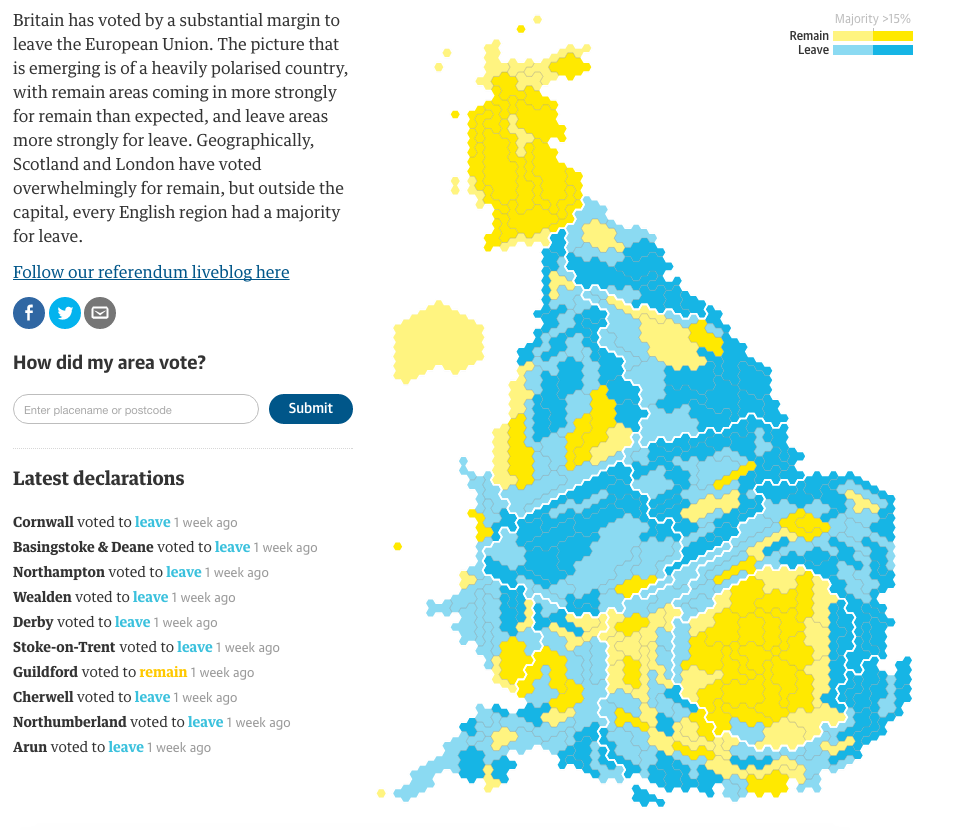
Instead of using a geographic map, the Guardian employs a cartogram with hexagons. I have covered similar uses a several times before today. The hexagon shape allows better retention of familiar geographic shapes, while still providing a means of solving the small district problem, especially in places like central London.
From another design perspective, that of colour, we see an improvement over the blue–yellow spectrum used by the BBC. You may recall from yesterday:
Having multiple tints and shades of yellow makes the map difficult to read.
Here, the Guardian instead opted for a simplified, and easier to read, two-step split. Bright blue and yellow with each have a call it half-tint. With only two blues and, more importantly, two yellows to distinguish, the map becomes easier to read. The trade-off, the darker of the colours represents anything above a 15% majority.
Clicking on the map then provides with a small summary of the district results.
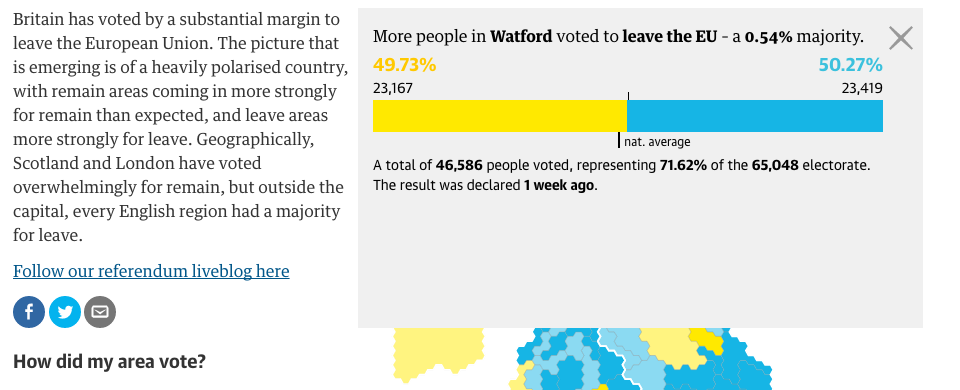
Here we see nothing too dissimilar from how the BBC treated the interaction with their map. A small, subtle design element I enjoy, however, is the inclusion of the national average. The 50% marker indicates clearly which side won, but the tick below the bar gives the reader context of where the district fell into relation to the remainder of the country.
And that leads us into the next set of comparisons.
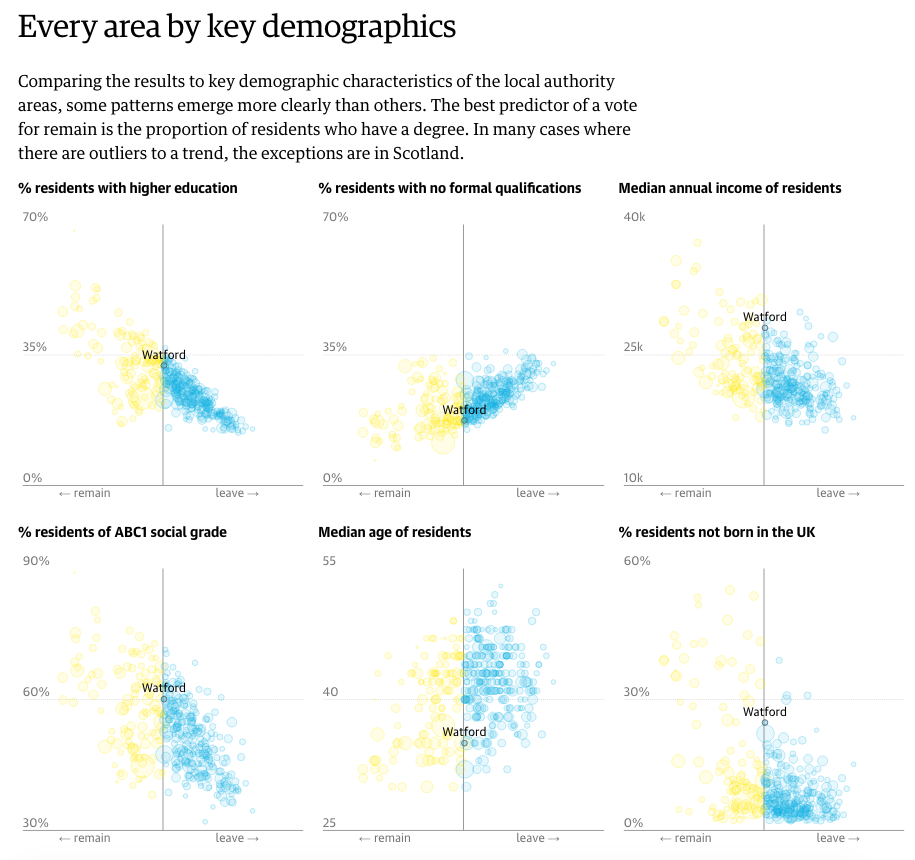
The Guardian took local district results and compared them against several different demographic and socio-economic indicators. This allowed them to present various correlations of the vote. It turns out that higher education correlated best with the results of the UK vote. From a design perspective, the linked circles provides some stability. However, I would have preferred the ability to click a geography and have it remain sticky and bring up the specific figures. Additionally, some sort of text search for geographies would be helpful.
And then the Guardian’s piece closes as strongly as it opened.
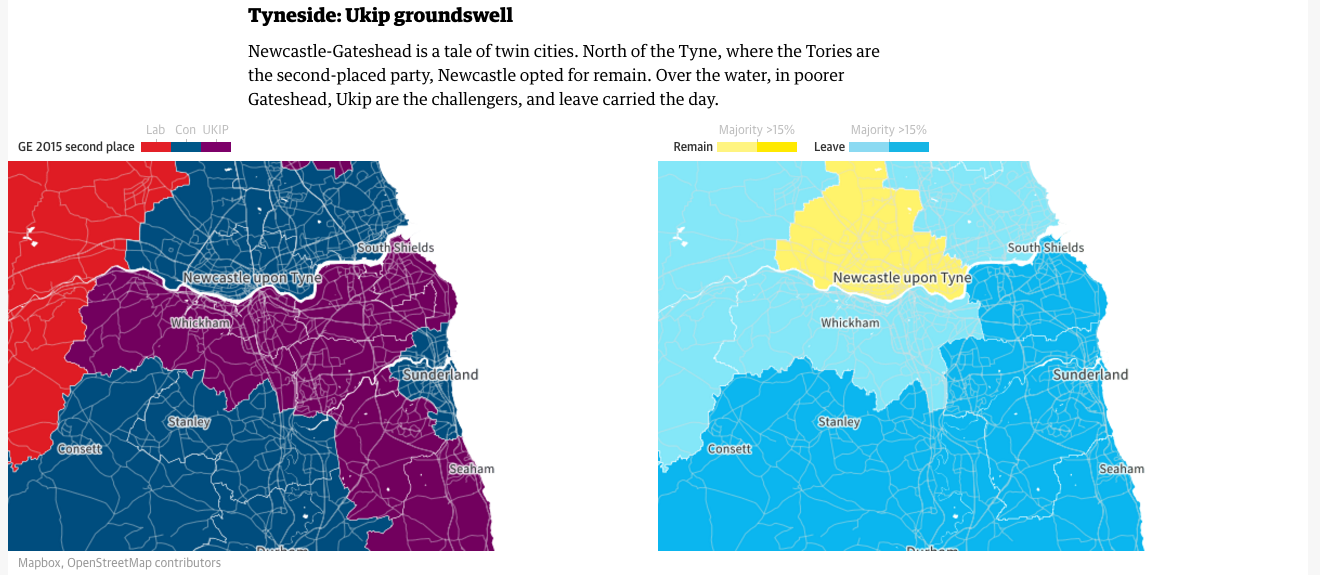
The piece examines three riverside areas to provide specific analysis to the vote. The screenshot above focuses on the Tyne, which runs alongside the aptly named Newcastle upon Tyne. The Guardian uses the previous general election results for the area to contrast with the referendum results. It does similar analysis for the Thames (London) and the Mersey (Liverpool).
Similar to the New York Times piece, the Guardian’s piece responds well to viewing the content on a small screen. The changes are less complex and they deal mostly with the arrangement of the various components instead of the layout of contextual data. But the Guardian clearly considered how the piece would work on a mobile phone up through a widescreen monitor.
Overall the piece is quite strong and does an excellent job of showcasing the results data and providing insightful analysis that complements the vote totals.
Credit for the piece goes to the Guardian graphics department.
So now it is two weeks since the Brexit vote. Yesterday, I looked at the results designs from the New York Times. Today I want to take a look at those of the BBC. Not surprisingly the two share in the use of choropleth maps; the choice makes a lot of sense. People vote within districts and those form the most granular unit of data available. But, whereas the New York Times led and really focused on one giant map, the BBC opted to use multiple, smaller maps. (They did choose a different page for their live results, but we are comparing post-result coverage.) For example, their piece leads in with a map of Leave’s results share.

There are a few key differences between this and the New York Times. First and foremost, this map is interactive. Mousing over various districts provides you the name, and by clicking you move into a zoomed-in view of the district. It displays the district name, the vote totals and share for the two camps, and then voter turnout. From a design standpoint, the problem with the zooming in is that the scales of the outlining stroke does not change.

A thin stroke at the national, zoomed-out view, translates to a thick, clunky, and awkward-looking outline at the local, zoomed-in view. And as the above screenshot highlights, many of the urban districts are small in comparison to the more rural districts. Unfortunately the map does not offer the functionality of zooming-in prior to selecting a district. So many of the districts in the more urban areas like London, Manchester, Birmingham, and Belfast are difficult to see and select. Thankfully, below the map the BBC offers a function to type in your district, post code, or Northern Irish constituency to help you find smaller districts.
Another design criticism I have with the piece is the colour palette. Broadly speaking, the piece uses blue and yellow. The two colours make sense in a few ways. Both are present on the European Union flag, with yellow stars on a blue field. (Importantly the twelve stars do not represent EU members like the US flag’s fifty stars represent the states.) Another, far looser interpretation could be the blue of the Conservatives and the yellow closer to the gold of the UK’s Liberal Democrats, the former broadly anti-EU and the latter pro-EU. Regardless of the rationale, the choice of yellow to display multiple levels of data is less than stellar (pun intended), as this Remain share map highlights.

Having multiple tints and shades of yellow makes the map difficult to read. The lowest value yellow is brighter than the next higher level, and so stands out more vividly on the map than those districts that had a higher share of Remain votes. Using yellow against blue does work, especially in the bar charts throughout the piece and seen in the aforementioned Islington screenshot. But, as a colour for wider, more intense use, yellow was not the wisest decision.
The BBC also included several other choropleth maps exploring the vote breakdown. In this instance of voter turnout, we have the same choropleth map, but a green colour indicating the total vote turnout.
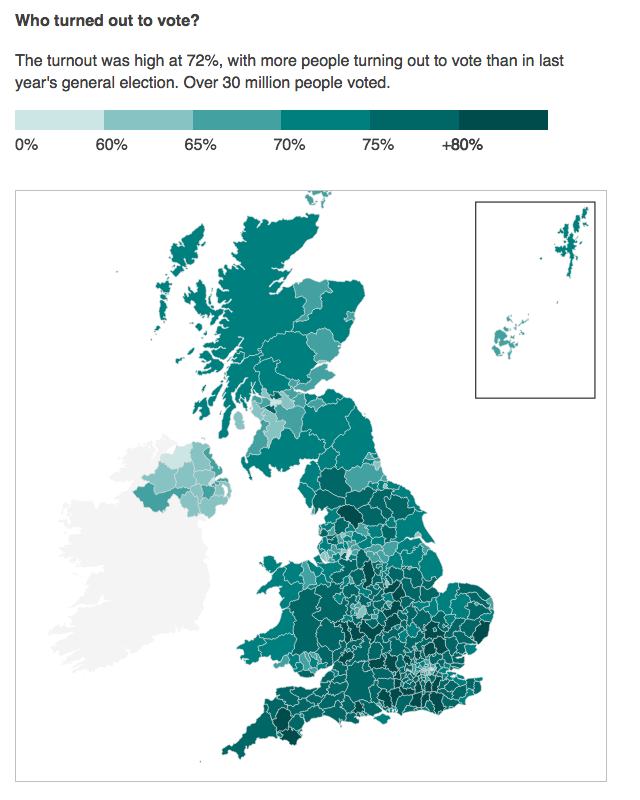
The colour and its choice makes broad sense; green is what one gets when they mix yellow and blue, when you combine Remain and Leave. However, the map functionality of clicking to reveal results still shows the overall results.

At this point, we have moved on from the vote results themselves to the breakdown of the vote. I would have redesigned the mouse-click to display a results view that highlighted turnout over the results themselves. Certainly keeping the results is important, but the focus of this map is not the vote, but the turnout. The data display should be designed to keep that consistent.
One part of the piece where I quibble with the designer selection of chart type follows on from turnout: a comparison of turnout to the youth population.
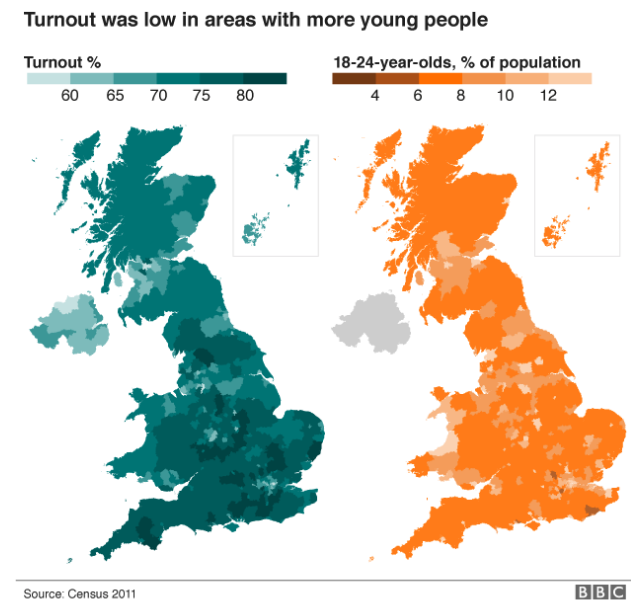
Asking people to compare undistinguished districts on one map to those of another—note the white district lines have here disappeared—is difficult. My first thought: I would have instead opted for an interactive scatterplot. Comparing the turnout on one axis and youth on the other, the user would have an easier time identifying any correlations or clusters of data.
In contrast, the following map comparison would not work via a scatterplot. Here we compare June’s results to those of a vote in 1975. In the intervening years, the geography of the voting districts changed, and so a one-to-one comparison is impossible.

The broad scope, however, is clear. A resounding vote to stay part of the European Market or single market in 1975 evolved into a narrow but decisive vote to leave the European Union in 2016.
The piece then closes out with an interactive map of the total results and then, importantly, a long list of bar charts showing each district’s results. Unlike the map, however, the bar charts are a static graphic. And with a few hundred to view, it becomes difficult to isolate and compare two in particular. But the selection of the visualisation type makes a user’s comparison far more precise.
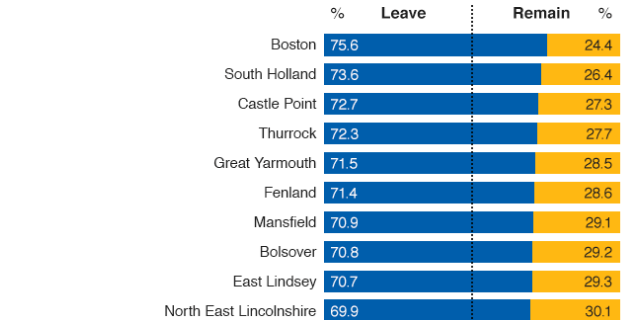
Overall, I would rate the piece a solid work, but with some clear areas of improvement. And who knows? Maybe there will be a second referendum. Or a new general election. And in that case, the BBC could improve upon the designs herein.
Credit for the piece goes to the BBC graphics department.
Well a little under two weeks later and here we are: Brexit. I wanted to take a moment in a slightly longer piece and comment on it. Not the results, because no, that I can leave to a pint at the pub. Instead I wanted to comment on this particular results content from the New York Times that I rather admire.
Overall the piece is not interactive; it features a static choropleth map with annotations and insets, particularly of greater London. On a side note, I would be remiss if I did not point out that similarly to the piece I wrote last week, this map omits a voting district: Gibraltar. Gibraltar, like Northern Ireland, borders the European Union directly via Spain. And despite voting overwhelmingly to remain in the EU, Gibraltar is omitted from these results.

In a large layout, the piece makes excellent use of annotation text to indicate the overview stories for the home nations of the United Kingdom: Scotland, Wales, and Northern Ireland. Northern Ireland, of course, will likely have to deal with the reintegration of border controls between the Republic of Ireland and Northern Ireland, a point the piece makes quite clear.
Additionally the map makes use of small elements to draw attention to data points, i.e. geographies, worth noting. London dominates the urban landscape, but other important cities like Belfast, Manchester, Birmingham are circled to show the strength of Leave/Remain. I would be curious to know the rationale behind including some areas, but omitting others, e.g. the strong Remain results in Cambridge or Brighton or the strong Leave results in Boston, require knowing just where cities are located in England.
From a design standpoint, the colours used in the map work really well together in contrast to other palette choices one could make. (We will take a look at that tomorrow.) Additionally, the shape of the United Kingdom allows for contextual elements, e.g. the regional result aggregates, to be placed much closer and nearer to the results. The space also allows for those annotations to be placed near their particular geographies.
But, what makes the piece stand out is when the user consumes it on smaller screens. On a more tablet-sized screen, we see a tweaked layout.

It makes use of the remaining wide-aspect dimensions to move the greater London results into a white space carved out by the peninsula of East Anglia. While the city and home nation labels remain, the regional annotations and results are gone from the graphic. Instead, they have been placed below the map, the main and most important part of the story.
Then for mobile phone or other narrow displays, the piece degrades even further.

City labels and circles are gone, with the exception of London. The greater London inset moves from alongside the map to now below the map, in the Channel so to speak. This layout allows for a narrow screen to better view the geographic results and then scroll down into the districts of London that require more space to be displayed. The annotations and stories remain below the graphic.
The design of the overall piece accounts nicely for at least three different screen sizes while keeping the story constant. All the truly changes is the layout of the graphic (and the loss of a few contextual labels at the smallest of sizes). Overall, it makes for a rich and compelling—and well designed—piece on the Brexit results.
Credit for the piece goes to Gregor Aisch, Adam Pearce, and Karl Russell.
The United Kingdom voted to leave the European Union. Kind of a big deal, right? After the vote, the New York Times put together a piece on just how connected Europe remains. For example, European defence can largely be considered guaranteed through NATO, to which the United Kingdom remains. The screenshot below details which European countries participate in the Schengen Zone and the Eurozone, the former creates a common border the latter a common currency.
I personally dislike the use of squares to represent European countries, with the size determined by the population. Granted the piece opens with a large map labelling every country, but it does require a user to have the ability to abstract the geography of Europe. Adding a degree of interactivity over each square would partially resolve the issue.
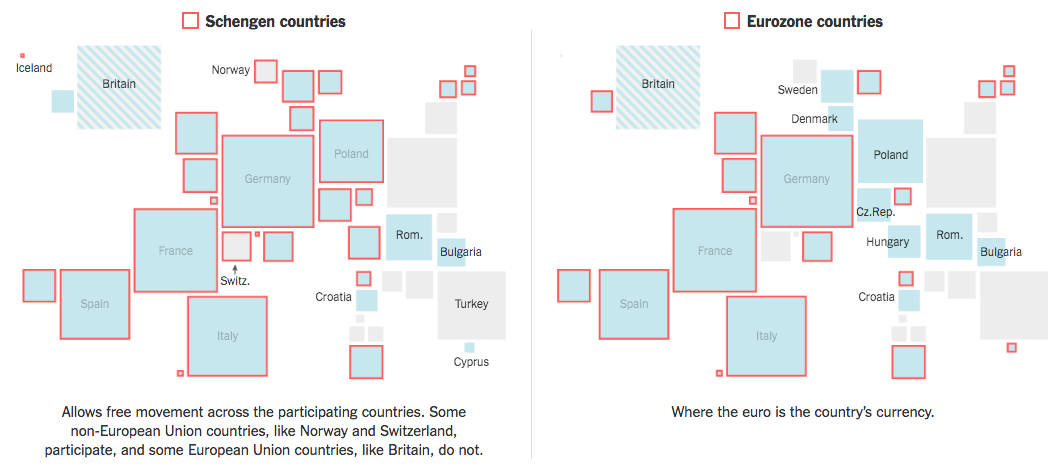
Credit for the piece goes to James Kanter and Iaryna Mykhyalyshyn.